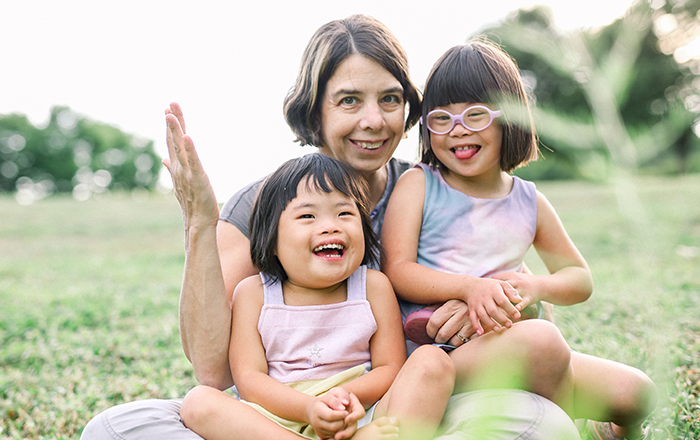Five years ago, my husband Pat and I knew nothing about open adoption. Today, we are staunch advocates of it and the very proud parents of two beautiful children who came home to us through open adoption. The journey to our children and to lovingly accept open adoption, however, was not an easy one. We learned that having an open mind was the key to having an open heart.
Limited Knowledge, Limited Contact
After our second miscarriage and a bleak forecast for a successful pregnancy, we decided to adopt. Like many prospective adoptive families, we began our journey to our children with limited information about adoption. Completely unaware of the vast adoption resources available or the need for them, we simply opened the Yellow Pages of our phone book and looked under adoption. We quickly located an adoption attorney who accepted us on his waiting list of families but cautioned us that our wait for a newborn would be at least 1 to 2 years. He told us that he believed in limited communication with birth parents, perhaps speaking with them on the phone but no face-to-face contact.
We didn’t question this philosophy; although we were not familiar with the terms closed or confidential adoption, from our limited knowledge, limited contact with birth parents made sense. In fact, we thought no post-adoption contact was the norm. Until we became more educated, we didn’t even consider that our children might need (and be entitled to) information about their birth heritage. In retrospect, instead of beginning our search by opening the Yellow Pages, we needed to begin by opening our minds to the special issues in adoption–and how they affect all parties to an adoption–as well as to the many options available to families.
Opening Our Minds
Fortunately for us–although it seemed unfortunate at the time–within a few months of signing with the attorney, Pat was offered a job that we agreed he could not refuse. Accepting the position, however, required us to relocate from Florida to North Carolina. When we told our attorney about the relocation, he told us that he did not place children outside the state. Thus, if Pat accepted the position, we would have to find another adoption attorney and begin our wait for a child all over again. Although the idea of starting over was unappealing, we knew the position was right for Pat.
The move led us to a wonderful adoptive parent support group, Southern Piedmont Adoptive Families of America (SPAFA). The group, which included adoptive families and prospective adoptive families, met monthly to exchange parenting ideas, discuss adoption options, and celebrate the arrival of children who had recently joined their families. From the first meeting, we felt at home with this group and became aware of how much we could learn from them. Through SPAFA, we immersed ourselves in adoption. We checked out books from the lending library. We talked with other families who had adopted–through attorneys and through agencies. We talked with families who had confidential adoptions, designated adoptions, semi-open adoptions, and open adoptions. We talked with families who had adopted internationally and with families who had adopted older waiting children. We sought out adults who had been adopted as infants.
The more we read and talked with others, the more we recognized the myths and misinformation about adoption pervasive in society, and the more empowered we felt to make the right decisions for ourselves and for our prospective children. Ultimately, a conversation Pat had with a coworker led us to pursue open adoption. “If you have a choice, consider open adoption,” he said. “Your child will thank you in the years to come.”
He went on to tell my husband that he and his twin brother, adopted as infants in a confidential adoption, had spent a lot of time while growing up wondering what their birth parents were like and why they had been placed for adoption. He assured my husband that our children would grow up feeling more complete and trusting if they knew where they came from, whom they looked like, and where they may have gotten certain talents, likes, and dislikes.
Opening Our Hearts
After deciding that we wanted an open adoption, we signed with an agency that advocated for open placements and attended a weekend orientation to acquaint us with the processes and procedures. We returned home to develop our “profile,” feeling ready to make an emotional commitment to a set of birth parents. Over the next few months, we received many phone calls from young women and couples facing an unplanned pregnancy. Each time we were hopeful that the call would lead to a placement, but repeatedly our hopes were dashed.
Although we had felt ready to make an emotional commitment, as we talked, listened, and cried with these expectant parents, we realized that our hearts were opening more to the realization of the adoption experience from the birth parents’ perspective. We felt increasingly more connected to these prospective parents and more fully able to comprehend their pain. At the same time, dealing with the emotional ups and downs was difficult for us. One young couple called us just weeks before their baby was due. We talked with them several times, trying to build trust before being summoned to be present for the birth. Sadly for us, but happily for them, the adoption did not take place. They chose instead to parent their daughter. We had opened our minds and our hearts to these birth parents and to the belief that we would become parents; instead the unthinkable had occurred. The birth parents had changed their minds. Although our agency director assured us that we would become parents if we stayed committed to our adoption plans, we felt we needed some time away from the emotional roller coaster of birth parent phone calls. We refocused our emotions and shortly before the Christmas holidays, we were again ready to pursue our dream of becoming parents.
Opening Our Arms
In January, we received a call from a young couple struggling to parent their 3-month-old daughter. Life was very difficult for them, and their relationship was strained. They had concluded that making an adoption plan for their daughter was what was best for each of them. Obviously very certain about what they wanted for their daughter, they asked us many probing questions about our morals, our religious beliefs, our family life, our views on discipline and child rearing, our career goals, and our educational plans for our children. When they learned that we were Catholic, they were concerned that we might be too strict and judgmental. As we talked through various issues, though, they decided that we would be able to provide all that they hoped for for their daughter.
A few weeks later, on January 17, in Dallas, we met this couple and for the first time held their baby girl–who was soon to be our daughter. The emotions connected with the placement that had fallen through quickly vanished. Holding this precious angel in our arms, we realized that this was our child. The other child had not been meant to be ours. We took placement of Katie one day later (appropriately enough at Love Airfield) and brought her home to await finalization.
Although Katie’s birth parents had requested only a letter and photograph each month for the first six months after placement, we found ourselves moving beyond our written agreement for extended communication almost immediately. Katie’s birth grandmother was not in favor of the placement and feared that we would not keep our end of the agreement. To convince her that we were sincere, I spent a great deal of time on the phone with her during the six months while we awaited finalization. I sent many photos to show her how Katie was growing and thriving. I also suggested that we get together when we returned to Texas to finalize the adoption. When finalization day arrived, we flew to Texas to appear in court, then, as agreed, headed to the home of one of Katie’s birth uncles where her birth grandmother had arranged an early birthday party for Katie. Birth family members brought presents and took lots of photos and videos. They were very considerate and respectful of us and very loving to Katie.
At the airport when Katie’s birth grandmother hugged us good-bye, she told us that although she had initially been against the placement, she was now in favor of it. We had convinced her that we were sincere in our intentions to maintain contact. We decided to get together again at Christmas time. Over the next two years, we got together several times and continued phoning and writing each other. As we spent time together, we evolved into more of an extended family and we realized how much we had in common. Katie’s birth parents, birth grandparents, and birth great grandmother all wanted to extend their love to Katie and to us. We saw no reason to prevent them from doing so.
Because our relationship with Katie’s birth family was so successful, when we decided to adopt again, we sought the same type of adoption. In November 1997, we spoke with a married couple from the Dallas area. After talking on the phone with them twice, they called us to ask us to be parents to their newborn son. We were able to adopt Kevin when he was only 5 days old. This time, Katie was the first one to open her arms and envelop her baby brother in love.
Advocating for Openness
Today, our commitment to open communication is stronger than ever. Gone are the written agreements for extended communication, and in place is a natural ebb and flow of friendship. We exchange e-mail messages, send letters and pictures, and call each of our children’s birth family members on a whim. On occasion, we have the opportunity to visit ALL our extended family (both children’s birth families as well as our extended family members) in Texas. We have even had Katie’s birth mother come stay with us at our house–thanks to the efforts of our adoption agency who arranged for her to speak to our local adoption support group. Although the visit was quick, it was an incredible experience. Aimee got to see Katie in her “home” environment, and we learned even more about each other during the visit. I saw firsthand was how much is genetically “coded.”
When I went to awaken Aimee one morning, I was shocked to see how much her slumbering face resembled Katie’s expression–or should I say how much Katie’s expression resembled her birth mother. I was overcome with awe and gratitude. I felt I had previewed what our daughter would look like as she approached womanhood. When we began our journey to open adoption, visitation was unthinkable. Now we–Pat and I and both sets of birth parents–are comfortable with our feelings. We realize the value of spending more than a few hours together. We are also watching our children grow in their knowledge and understanding of adoption and of their own unique heritage. For us, open adoption not only works–it is a blessing!



